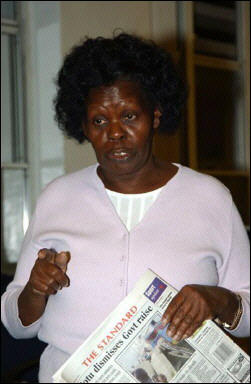Featured
It seems Moses Kuria, the man of many portfolios, embarked on a whirlwind adventure through the halls of government, only to find himself in a comedic conundrum. Starting off strong as the Cabinet Secretary for Investments, Trade, and Industry, he was the talk of the town. But alas, fate had other plans. In a twist fit for a sitcom, Kuria found himself shuffled over to the Public Service portfolio faster than you can say "bureaucratic shuffle". Then, the plot thickened! In a classic case of diplomatic drama, the US Trade Representative, Katherine Tai, decided to give Kuria a cold shoulder after cancelling not one, but two meetings with him. The reason? His "foul mouth". Oh, the irony! It seems even the most seasoned politicians can't escape the wrath of a sharp tongue. Since then, Kuria has seemingly vanished into thin air, keeping a low profile that would make even Bigfoot jealous. Rumour has it he's taken up residence in a cozy cave somewhere, pondering th
- Get link
- Other Apps
Posted by
Amkeni Ndugu Zetu!
The Assassination of Patrice Lumumba Was Ordered By U.S. President Dwight Eisenhower
On 17 January 1961, Patrice Emery Lumumba, an African icon and the first democratically elected Prime Minister of Congo, met a tragic end in the remote forests of Katanga Province in southeastern Congo. Lumumba's assassination, just seven months after assuming office following Congo's independence from Belgium on 30 June 1960, remains a dark stain on the annals of African history.
The events leading to Lumumba's demise are shrouded in secrecy and betrayal. Forced out of office and subsequently killed, Lumumba's remains were callously buried in a mass grave alongside two of his political allies. Reports suggest that Belgian authorities, including the Belgian Counsel General in Congo, played a direct role in orchestrating Lumumba's murder.

The brutal manner in which Lumumba's body was treated after his death further underscores the heinous nature of the crime. Belgian authorities, including police commissioner Gerard Soet, confessed to desecrating Lumumba's remains by dismembering his body, burning the pieces, and subjecting them to sulfuric acid. Soet's admission on Belgian television, accompanied by the display of Lumumba's teeth, sparked outrage and renewed calls for justice.
Eyewitness accounts from Congolese locals, such as Lwimba Mutifu Njiba, provide harrowing details of the night of Lumumba's assassination. Njiba recounts how he and his father stumbled upon the scene while returning from a hunting trip, witnessing the execution of Lumumba and his companions by soldiers. Their bodies, hastily buried in a shallow grave, bore the unmistakable signs of a violent end.
Eyewitness accounts from Congolese locals, such as Lwimba Mutifu Njiba, provide harrowing details of the night of Lumumba's assassination. Njiba recounts how he and his father stumbled upon the scene while returning from a hunting trip, witnessing the execution of Lumumba and his companions by soldiers. Their bodies, hastily buried in a shallow grave, bore the unmistakable signs of a violent end.
Despite efforts to erase Lumumba's physical presence from history, his legacy as a martyr for African independence endures. He remains a symbol of resistance and resilience, revered not only in Congo but across the African continent and the wider world. The tragic fate of Patrice Lumumba serves as a stark reminder of the sacrifices made in the struggle for freedom and justice in Africa.
- Get link
- Other Apps
Labels:
Assassination of Lumumba
Assassination of Patrice Lumumba
Belgium
Congo
Dwight Eisenhower
Katanga Province
Lumumba
Lumumba's assassination
Patrice Emery Lumumba
Patrice Lumumba
President Eisenhower
Popular Posts

Posted by
Amkeni Ndugu Zetu!
Who’s Nailin’ Paylin?
- Get link
- Other Apps

Posted by
Amkeni Ndugu Zetu!
A selection of Kenyan women
- Get link
- Other Apps


Comments